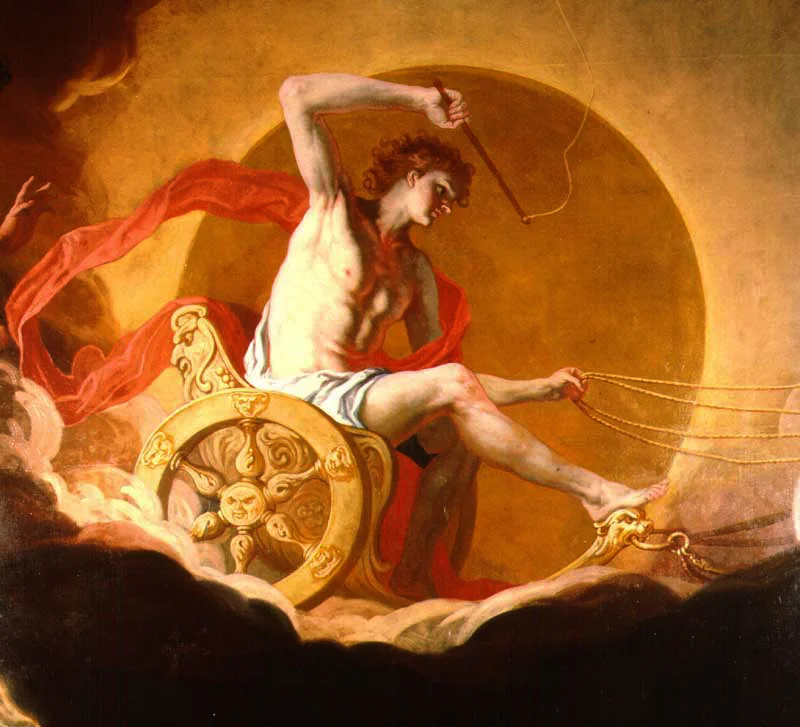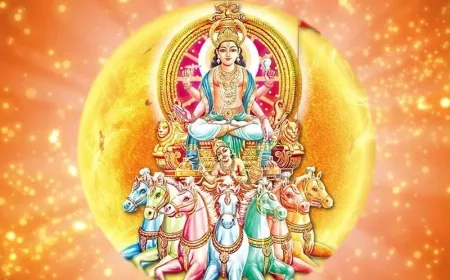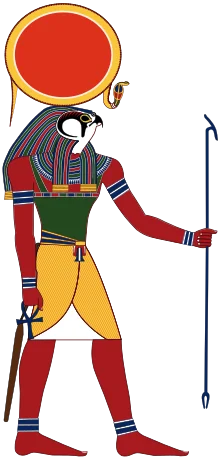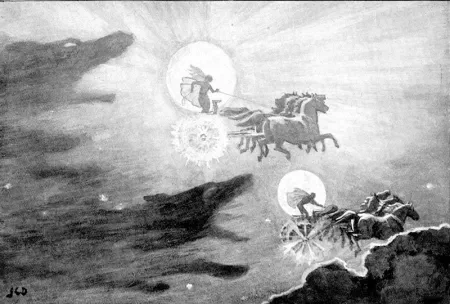
Last time on the history of solar, we talked about the wholly practical side of things. How humanity has made use of the sun’s power over the millennia. But there’s more to it than that; after all, legends, gods and myth have been a part of humanity’s history since the very beginning. Ever since we first started recording our history, the sun has been venerated as a deific force everywhere in the world.
We may approach things more scientifically in the modern era, but even now, plenty of religions contain a god devoted to maintaining or controlling the sun, and almost every mythological pantheon around the world will have one, whether they pull the sun on a blazing chariot, command its rays as a disc over their head, or simply are the sun. Wherever you look, mankind has looked up to the blazing star in the centre of our solar system, and seen something mythical and mighty.
Greek Mythology: Helios

In Greek mythology, we have Helios. You may recognise Helios as his imposing bronze statue, the colossus of Rhodes, was one of the seven great wonders of the ancient world, standing a mighty thirty-three meters tall.
Helios is the first of the gods on this list who show a surprisingly common fondness for chariots. In his case, he pulled the sun along on a flaming chariot, pulled by pegasi, winged horses. During the day, he would ride from Ethiopia in the east, to Hesperides in the west, giving the world light. At night, he would take a more leisurely trip home in a golden bowl floating along the ocean.
Helios’ history is not quite as storied as many other Greek gods, though his most prolific and tragic story goes like this. His son, Phaethon, learned that his father was the sun, and ventured all the way to the east to the morning dawn, and met him there to request a gift from him. Helios said he would give his son anything in the world that he could offer, and his son requested to take his place, pulling the sun for but a day. But Phaethon could not control the chariot’s wild and willful horses, and the flaming chariot went wild across the sky, spinning out of control and towards the earth. To stop the earth being consumed in an eternal flame, Zeus struck the chariot, along with Helios’ son, out of the sky with a lightning bolt.
In Ancient Greece as a whole, Helios was not a major deity, though many would pray to him or give thanks to him with the rising of the morning sun. However, in Rhodes, Helios was the principal deity, with the people of the nation believing that the champions of the region were the descendants of Helios and the nymph the region drew its name from, Rhodos.
Hindu Mythology: Surya

“The bringer of the sun, Surya, was thought to ride his chariot across the sky & defeat the demons of darkness.” - Notes upon the Rigveda, the oldest of the Vedas sacred texts.
Another deity known for his great flaming chariot, with which he would pull the sun across the sky, Surya was considered the creator of the universe, and the source of all life. He was considered one of the three most important deities during the Vedic period, which took place around 1500 to 500 BCE. In the modern era, Surya has somewhat fallen in his importance in general worship, having been supplanted by deities such as Shiva and Vishnu, but he still remains a very important deity in several regions of India and Nepal. He has also been incorporated as a minor deity in Buddhism as well.
One of the more interesting stories of Surya is that, possibly in an attempt to make his light more bearable for those around him, Vishwakarma, the god of architecture, and the personification of ultimate reality, chipped away at Surya. Doing so dimmed his light, and made it easier for Samjna, daughter of Vishwakarma and Surya’s lover, to live with him. The pieces of the god which were chipped away, these flaming fragments, would be reforged into many of the legendary weapons wielded by other gods in the pantheon, such as Shiva’s trident.
Egyptian Mythology: Ra

Like Surya, Ra, the sun god of Egyptian mythology, is also considered the creator deity, father of all the other gods. The legends state that, at the beginning of time, Ra pulled himself from the sea of chaos, onto the island of the world, and birthed several other deities, who would then go on to birth many more.
Ra’s role in history is quite interesting, as several of his children were actually worshipped before him, and several other deities have been folded into, or have been made to be considered aspects of Ra, such as Atum, the creator deity, who would go on to be considered as Ra when the latter rose in prominence.
There are many legends about Ra’s travel across the sky, but one of the more prevalent legends goes as such: the sky, which is the goddess Nut, would carry Ra across her back, he would travel up her spine throughout the day, giving light to the world, only to be devoured by her as the sun set. Then, in the morning, he would be born again, and repeat the cycle.
It is said that in many temples of Ra, there would be no statues of the deity; instead, the temple would be designed to allow rays of sunlight to fill the temple, and these would be what one venerated, Ra’s light, filling the place of worship. The most significant of these solar temples was in Heliopolis.
Norse Mythology: Sol (and Mani)

Sol, along with her brother Mani, are the Norse deities of the sun and moon, each carrying their respective celestial orb on the back of a great flying chariot, chased by great wolves.
The legends surrounding their creation differ, with some stating that they are the children of a particularly boastful mortal. Most, however, say that the twin gods were born at the creation of the universe, with no understanding of their purpose in the world. They convened with the other gods, who helped them decide their role in the universe by creating the days, years, and phases of the moon, to allow the pair to fit into the great scheme of things.
So it was, that, with their place found in the world order, the pair took to racing across the sky day and night, somewhere along the way, they began to be chased by the children of the great wolf Fenrir, Skoll (One who mocks), and Hati (One who hates). These wolves were blamed for eclipses, as it was believed celestial events were caused by the wolves getting close enough to take a bite out of the fleeing gods.
Like many Norse myths, much of the gods' story revolves around their involvement in Ragnarok, the end of all things, and the beginning of the new world. It is said that in the end times, as Fenrir devoured the world, Skoll and Hati would finally catch their quarry, and drive the world into darkness. In time, Sol’s daughter, sometimes named Sol as well, other times called Sunna, would be born, and give light to the new, perfect and peaceful world that would come after Ragnarok in place of her mother.
Japanese Mythology: Amaterasu

Last but certainly not least, we have Amaterasu, daughter of creator deities Izanagi and Izanami. Her name is actually shorthand, for her full name is Amaterasu-Omikami, which can be translated as The great and glorious kami who illuminates from heaven. Amaterasu is the centre of Shinto, and Japanese spiritual life, as well as the mythological source of the ancient Japanese emperor’s right to rule.
She is considered the creator deity, though she herself did not create the universe; instead, she inherited this title from her father, who now defends the world of the living from the world of the dead. She represents order and purity, two of the most important concepts in Shinto worship. All things are ordered, with Amaterasu, queen of the gods, at the top of this hierarchy.
It was said that the Japanese imperial family is descended from Amaterasu, and so it is their god-given right to rule, and their divine duty to reflect the order and harmony that Amaterasu imposes on heaven onto the world of man, through their own work as rulers.
One of the most famous stories about Amaterasu has her in a quarrel with her brother, Susanoo, the god of storms, before his exile to rule over the oceans. Each gave the other their artifact, and from these artifacts, both gods birthed new deities. Susanoo birthed five gods from his sister's grand jewel, while she birthed only three from his divine blade. As the grand jewel was her artifact, she claimed this made her the victor.
Susanoo flew into a rage, killing animals, causing storms, destroying rice fields, even going so far as to flay a horse and hurl it at his sister while she worked with her handmaiden at her favourite loom, killing her handmaiden, who Amaterasu cared for. Amaterasu took responsibility for this rampage, seeing it as her fault for childishly goading her brother, and so she exiled herself into a cave to mourn and repent, plunging the world into darkness. It was only through arousing her curiosity with a grand party, and uproarious laughter, that the other gods were able to lure her back out, at which point they sealed the cave behind her with a sacred rice straw rope so that she could not hide away in it again.
As you can well see, in so many religions around the world, the sun is venerated not only as a god, but the source of life, and even the king, or queen of gods. Ever since the dawn of history, we have looked to the sky and seen a benevolent force. Even if it is not done in as mythical a fashion as it once was, even now, we look to the sky and see something amazing.



